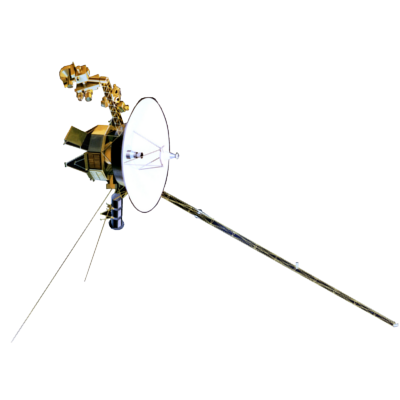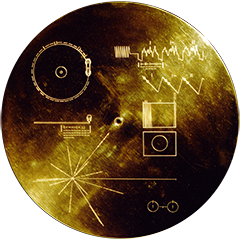Voyager LECP Data Analysis Handbook
Data File Descriptions
Supplementary EDR
SEDR Software Interface Specification
From Document 4-7008-1, Rev. B
| Generating Program: |
SEDRGEN | User Program: |
Fixed Instrument PI SEDR Processors |
| Computer System: |
UNIVAC 1108 | Computer System: |
Purpose of Interface
To provide the fixed or direct sensing instrument Principal Investigators with the prevailing navigation and orientation conditions when their scientific data were obtained.
Interface Device
Magnetic tape of seven or nine tracks written at a tape density of 800 BPI using odd lateral parity. The tape will contain a single file termed "Fixed Instrument SEDR File."
Data Code
The Fixed Instrument SEDR will be composed of 32-bit words which contain character, integer and floating point quantities. All character data will be Left Justified Space Filled (LJSF) in the standard IBM 360 EBCDIC code. All integer quantities will be in the 2's complement form. The floating point words will be in the standard IBM 360 format which is given below. In general, the tape will appear as if it had been written on an IBM 360.
IBM 360 Floating Point Word Format
| Bit | 0 | 1 7 | 8 31 |
| Sign | Char | Fraction |
where
Sign indicates the sign of the quantity represented by the floating point word. If Sign = 0, the quantity is positive. If Sign = 1, the quantity is negative.
Char indicates the location of the hexadecimal point of the fraction portion of the word. This value is normalized to a hexadecimal value of 40 such that Char - 40 (hexadecimal arithmetic) locates the hexadecimal point to the right when positive and to the left when negative. The Char can also be considered as a decimal scale factor which the fraction when evaluated as a decimal number must be multiplied by to properly evaluate the quantity. Under this scheme, the normalized value is 64 (decimal) and the scale factor is the (Char - 64)th power of 16.
Fraction contains the significant digits of the quantity with the hexadecimal point located to the left of bit 8.
The following algorithm could be used to evaluate floating point quantities from this format:
VALUE10 = (1 - 2*SIGN10) * (FRACTION10) * 1610 ** (CHAR10 - 6410)
Recording Method
UNIVAC 1108 System Library Routine, IOW (binary read/write routine)
Detailed Interface Definition/Format
The SEDRGEN Program will write a 9 track magnetic tape for the CRS, PRA, PLS, MAG, LECP, RSS, IRIS, PPS and UVS PIs and a 7 track magnetic tape for the PWS PI. All words will be 32 bits in length and all physical records except for the header record will contain the same number of words for any single SEDR. The following attachments to this document describe the structure and content of the Fixed Instrument SEDR File.
- Attachment A, Fixed Instrument SEDR File Layout
- Attachment B, Fixed Instrument SEDR Header Record Format
- Attachment C, Navigation Data Block Format for Launch Period
- Attachment D, Navigation Data Block Format for Cruise Periods
- Attachment E, Navigation Data Block Format for Jupiter Encounter
- Attachment F, Navigation Data Block Format for Saturn Encounter
- Attachment G, Pointing Vector Data Block Format
- Attachment I, Fixed Instrument SEDR Format, Uranus Encounter Navigation Block
Definition of Terms
| Cartesian State | Cartesian position and velocity components in the following order: X-position, Y-position, Z-position, X-velocity, Y-velocity, and Z-velocity. | |
| Celestial Clock and Cone Angles | Clock and cone angles centered at the S/C with respect to the Sun-S/C-Canopus (ABC) reference system. | |
| Equinox | Refers to the vernal equinox, i.e., for the planets the vernal equinox is defined as the axis from the center of the planet to the ascending node of the planet's orbit through the planet's equatorial plane. | |
| Jupiter System I Prime Meridian |
This prime meridian system is identified with the rotation of the visible features in the Jovian equatorial zone. The exact definition of this system can be found in the Explanatory Supplement to The Astronomical Ephemeris and The American Ephemeris and Nautical Almanac (Explanatory Supplement to the Ephemeris). JPL Technical Report (TR) 32-1508, dated January 15, 1971, also contains the definition. | |
| Jupiter System III Prime Meridian |
This prime meridian system is identified with the rotation of radio emissions from Jupiter. This rotation probably corresponds to the rotation of the Jovian inner core which is associated with the planet's magnetic field. The present System III is formally known as "System III (1957.0), which is precisely defined in the U.S. Naval Observatory Circular No. 137, dated March 14, 1972. However, the International Astronomical Union (IAU) is planning to adopt a new System III definition sometime during the summer of 1976. This prime meridian system will be denoted "System III (1965.0)". Note that the SEDR will contain the system which is currently sanctioned by the IAU which will most likely be the latter system. Reference to the former system is given only because the latter system has not been formally defined and to give interested readers some idea of the essence of this prime meridian system. | |
| Saturn Prime Meridian | This system is a JPL defined system which assumes a constant rotational rate of the prime meridian and a zero hour angle of the equinox at the epoch of 1950, January 1.0. The exact definition of this system can be found in JPL Technical Report 32-1508, dated January 15, 1971. | |
| Longitudes | The longitude conventions will conform to the IAU standards which specify positive west longitudes for both Jupiter and Saturn. |
Glossary
| BPI | Bits per Inch | |
| C | Character Quantity | |
| CRS | Cosmic Ray Subsystem | |
| deg | degrees | |
| dim | dimensionless | |
| DPTRAJ | Double Precision Trajectory Program | |
| E | Floating Point Quantity | |
| FDSC | Flight Data Subsystem Count | |
| FIP | Fixed Instrument Pointing | |
| GMT | Greenwich Mean Time | |
| HET | High Energy Telescope | |
| HHMMSS | Hours-Minutes-Seconds | |
| HGA | High Gain Antenna | |
| I | Integer Quantity | |
| IAU | International Astronomical Union | |
| IRG | Inter-Record Gap | |
| IRIS | Infrared Interferometer Spectrometer and Radiometer Subsystem | |
| JPL | Jet Propulsion Laboratory | |
| km | kilometers | |
| km/sec | kilometers per second | |
| LECP | Low Energy Charged Particle Subsystem | |
| LET | Low Energy Telescope | |
| LJSF | Left Justified Space Filled | |
| MAG | Magnetometer Subsystem | |
| MMDDYY | Month-Day-Year | |
| MOD | Modulo | |
| msec | milliseconds | |
| PI | Principal Investigator | |
| PLS | Plasma Subsystem | |
| PPS | Photopolarimeter Subsystem | |
| PRA | Planetary Radio Astronomy Subsystem | |
| PWS | Plasma Wave Subsystem | |
| RSS | Radio Science Subsystem | |
| SCE | Spacecraft Event Time | |
| sec | seconds | |
| SEDR | Supplementary Experiment Data Record | |
| SEDRGEN | Supplementary Experiment Data Record Generation Program | |
| S/C | Spacecraft | |
| TET | The Electron Telescope | |
| UVS | Ultraviolet Spectrometer Subsystem |
Return to SEDR Table of Contents
Return to Data File Descriptions main page.
Return to Voyager
LECP Data Analysis Handbook Table of Contents.
Return to Fundamental
Technologies Home Page.
Updated 8/9/19, Cameron Crane
VOYAGER 1 ELAPSED TIME
*Since official launch
September 5, 1977, 12:56:00:00 UTC
VOYAGER 2 ELAPSED TIME
*Since official launch
August 20, 1977, 14:29:00:00 UTC
QUICK FACTS
Mission Duration: 40+ years have elapsed for both Voyager 1 and Voyager 2 (both are ongoing).
Destination: Their original destinations were Saturn and Jupiter. Their current destination is interstellar space.



